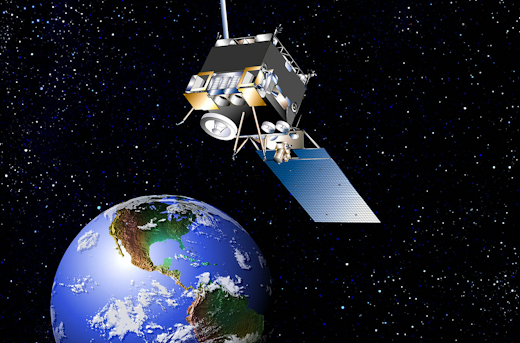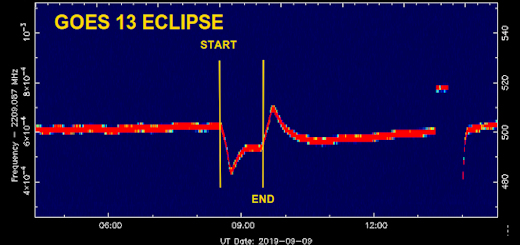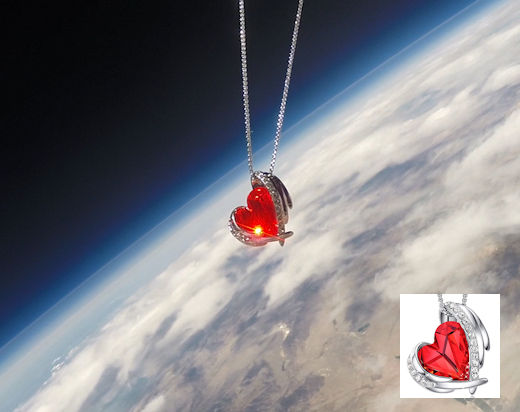Solar minimum is here - but even now strangely beautiful auroras are dancing around the poles. Deep inside the Arctic Circle, the expert guides of Aurora Holidays in Utsjoki, Finland, can help you chase them. Book now! | | |
SERVER UPDATE: Thank you for your patience as we move Spaceweather.com to a new secure high-performance server. One of the last outstanding problems has been solved: Our archives are working for all date ranges now. If you find other errors on the site please email us to let us know.
THE MYSTERIOUS MOVEMENTS OF GOES-13: Scott Tilley has an unusual hobby. He scans the skies for satellites where they shouldn't be. Using an S-band receiver, the amateur radio operator has tracked many classified spacecraft orbiting Earth and famously found NASA's IMAGE satellite when it woke up from the dead last year. This past weekend he bagged another one: GOES-13.

"This was quite a surprise," says Tilley. "I thought GOES-13 was in a graveyard orbit--yet I found it quite active and wandering on Sept. 8th."
GOES-13 is a NOAA weather satellite. It was retired in January 2018 after a storied 12-year career during which it monitored some of the most notorious weather events in recent U.S. history – including Hurricane Sandy in 2012 and the triple disaster of Hurricanes Harvey, Irma and Maria in 2018. The satellite also experienced significant space weather: In December 2006, GOES-13 observed a solar flare so intense it damaged its onboard Solar X-ray Imager.
When weather satellites are retired, they are typically steered into a high parking orbit for storage. GOES-13 was reportedly "parked" over longitude 60W. But that's not where Tilley found it.

Above: GOES-13 S-band signals received by Scott Tilley on Sept. 8, 2019.
"It was drifting westward through longitude 135W," he says. "As it was emitting strong radio signals it seemed to me it was going somewhere and with no public statements I could find about this it encouraged me to start an observing campaign."
Tilley quickly focused his attention on the night of Sept. 9th when the satellite would drift through Earth's shadow--essentially experiencing a solar eclipse. Would the solar powered satellite survive the blackout?
"Indeed it did," reports Tilley. "Strong radio transmissions continued before, during and after the eclipse. GOES-13 still has a working battery."

Above: GOES-13's response to a solar eclipse, indicating what appears to be nominal battery operation.
This is significant, Tilley explains, because "satellite batteries are sometimes intentionally disconnected as part of their retirement process. The idea is to ensure the battery doesn't explode or do something else unwelcome after the system is shutdown and create unintentional space debris. In my mind, a good battery seals the notion that GOES-13 is operational."
But what is the operation? Tilley suspects that GOES-13 may have been drafted by the US military. News reports earlier this year suggested that the US Air Force is interested in using retired weather satellites as observing platforms. Before GOES-13 was "retired," its visual imaging system was still fully functioning.
"Only time will tell where GOES-13 ends up," says Tilley. "But given the nature of these observations there is no doubt in my mind the spacecraft is alive and under intelligent control. The question is, who is the intelligence?"
For a fuller discussion of Tilley's observations, check out his blog post.
Realtime Space Weather Photo Gallery
Free: Spaceweather.com Newsletter
THE ANTARES PENDANT: Are you looking for a far-out gift? Consider the Antares Pendant. On Aug. 19, 2019, the students of Earth to Sky Calculus launched a cosmic ray balloon to the edge of space, 104,002 ft high. This ruby-red crystal necklace went along for the ride:

You can have it for $179.95. The students are selling these white gold-plated pendants to support their cosmic ray ballooning program. The glittering Swarovski crystal has a deep ruby hue inspired by the red-supergiant star Antares in Scorpio. Each one comes with greeting card showing the pendant in flight and telling the story of its journey to the edge of space and back again.
Far Out Gifts: Earth to Sky Store
All sales support hands-on STEM education
Realtime Aurora Photo Gallery
Free: Spaceweather.com Newsletter
Every night, a network of
NASA all-sky cameras scans the skies above the United States for meteoritic fireballs. Automated software maintained by NASA's Meteoroid Environment Office calculates their orbits, velocity, penetration depth in Earth's atmosphere and many other characteristics. Daily results are presented here on Spaceweather.com.
On Sep. 11, 2019, the network reported 45 fireballs.
(42 sporadics, 3 Sept. epsilon Perseids)

In this diagram of the inner solar system, all of the fireball orbits intersect at a single point--Earth. The orbits are color-coded by velocity, from slow (red) to fast (blue). [Larger image] [movies]
Potentially Hazardous Asteroids (
PHAs) are space rocks larger than approximately 100m that can come closer to Earth than 0.05 AU. None of the known PHAs is on a collision course with our planet, although astronomers are finding
new ones all the time.
On September 12, 2019 there were 2015 potentially hazardous asteroids.
 |
Recent & Upcoming Earth-asteroid encounters: | Asteroid | Date(UT) | Miss Distance | Velocity (km/s) | Diameter (m) |
| 2019 RD1 | 2019-Sep-06 | 6.1 LD | 7.1 | 15 |
| 2019 GT3 | 2019-Sep-06 | 19.5 LD | 13.6 | 211 |
| 2019 RA | 2019-Sep-07 | 4.5 LD | 5.7 | 29 |
| 2019 RC1 | 2019-Sep-07 | 0.5 LD | 20.4 | 6 |
| 2019 QZ | 2019-Sep-08 | 15.7 LD | 4.3 | 22 |
| 2019 RX1 | 2019-Sep-09 | 9.7 LD | 13.3 | 30 |
| 2019 QZ3 | 2019-Sep-09 | 9.7 LD | 7.5 | 40 |
| 2019 RG2 | 2019-Sep-09 | 1.4 LD | 22 | 12 |
| 2019 QY4 | 2019-Sep-10 | 2.5 LD | 7.8 | 10 |
| 2019 RH | 2019-Sep-10 | 7 LD | 16.8 | 23 |
| 2019 RX2 | 2019-Sep-12 | 7.2 LD | 5.3 | 7 |
| 2019 RJ1 | 2019-Sep-12 | 10.8 LD | 10.4 | 15 |
| 2010 RM82 | 2019-Sep-13 | 18.2 LD | 14.6 | 23 |
| 2013 CV83 | 2019-Sep-13 | 16.1 LD | 13.1 | 62 |
| 504800 | 2019-Sep-14 | 13.9 LD | 14.4 | 155 |
| 2019 RT | 2019-Sep-14 | 13.7 LD | 16.6 | 48 |
| 2019 RQ2 | 2019-Sep-14 | 9.4 LD | 17.2 | 30 |
| 467317 | 2019-Sep-14 | 13.9 LD | 6.4 | 389 |
| 2019 JF1 | 2019-Sep-16 | 11.2 LD | 4.3 | 62 |
| 2018 FU1 | 2019-Sep-16 | 18.4 LD | 4.7 | 16 |
| 2019 RC | 2019-Sep-16 | 17.5 LD | 15.1 | 155 |
| 2019 RP2 | 2019-Sep-20 | 8.5 LD | 1.6 | 6 |
| 2017 SL16 | 2019-Sep-21 | 7.9 LD | 6.5 | 25 |
| 2017 SM21 | 2019-Sep-21 | 11.5 LD | 9.6 | 20 |
| 2019 RE2 | 2019-Sep-21 | 19.7 LD | 8.7 | 38 |
| 2019 RB3 | 2019-Sep-21 | 19 LD | 11.8 | 51 |
| 2019 QZ1 | 2019-Sep-22 | 12.5 LD | 8.2 | 77 |
| 523934 | 2019-Sep-24 | 10.9 LD | 22.3 | 257 |
| 2019 QY3 | 2019-Sep-26 | 13.9 LD | 8.4 | 41 |
| 2017 KP27 | 2019-Sep-26 | 4.2 LD | 4.7 | 25 |
| 2006 QV89 | 2019-Sep-27 | 18.1 LD | 4.1 | 31 |
| 2018 FK5 | 2019-Oct-01 | 13.3 LD | 10.5 | 8 |
| 2018 LG4 | 2019-Oct-02 | 13.8 LD | 8.1 | 12 |
| 2017 TJ4 | 2019-Oct-05 | 13.5 LD | 8.9 | 32 |
| 2019 RK | 2019-Oct-08 | 16.7 LD | 3.1 | 32 |
| 162082 | 2019-Oct-25 | 16.2 LD | 11.2 | 589 |
| 2017 TG5 | 2019-Oct-25 | 14.4 LD | 11.9 | 34 |
| 2015 JD1 | 2019-Nov-03 | 12.9 LD | 11.9 | 269 |
Notes: LD means "Lunar Distance." 1 LD = 384,401 km, the distance between Earth and the Moon. 1 LD also equals 0.00256 AU. MAG is the visual magnitude of the asteroid on the date of closest approach. | | Cosmic Rays in the Atmosphere |
SOMETHING NEW! We have developed a new predictive model of aviation radiation. It's called E-RAD--short for Empirical RADiation model. We are constantly flying radiation sensors onboard airplanes over the US and and around the world, so far collecting more than 22,000 gps-tagged radiation measurements. Using this unique dataset, we can predict the dosage on any flight over the USA with an error no worse than 15%.
E-RAD lets us do something new: Every day we monitor approximately 1400 flights criss-crossing the 10 busiest routes in the continental USA. Typically, this includes more than 80,000 passengers per day. E-RAD calculates the radiation exposure for every single flight.
The Hot Flights Table is a daily summary of these calculations. It shows the 5 charter flights with the highest dose rates; the 5 commercial flights with the highest dose rates; 5 commercial flights with near-average dose rates; and the 5 commercial flights with the lowest dose rates. Passengers typically experience dose rates that are 20 to 70 times higher than natural radiation at sea level.
To measure radiation on airplanes, we use the same sensors we fly to the stratosphere onboard Earth to Sky Calculus cosmic ray balloons: neutron bubble chambers and X-ray/gamma-ray Geiger tubes sensitive to energies between 10 keV and 20 MeV. These energies span the range of medical X-ray machines and airport security scanners.
Column definitions: (1) The flight number; (2) The maximum dose rate during the flight, expressed in units of natural radiation at sea level; (3) The maximum altitude of the plane in feet above sea level; (4) Departure city; (5) Arrival city; (6) Duration of the flight.
SPACE WEATHER BALLOON DATA: Approximately once a week, Spaceweather.com and the students of Earth to Sky Calculus fly space weather balloons to the stratosphere over California. These balloons are equipped with radiation sensors that detect cosmic rays, a surprisingly "down to Earth" form of space weather. Cosmic rays can seed clouds, trigger lightning, and penetrate commercial airplanes. Furthermore, there are studies ( #1, #2, #3, #4) linking cosmic rays with cardiac arrhythmias and sudden cardiac death in the general population. Our latest measurements show that cosmic rays are intensifying, with an increase of more than 18% since 2015:

The data points in the graph above correspond to the peak of the Reneger-Pfotzer maximum, which lies about 67,000 feet above central California. When cosmic rays crash into Earth's atmosphere, they produce a spray of secondary particles that is most intense at the entrance to the stratosphere. Physicists Eric Reneger and Georg Pfotzer discovered the maximum using balloons in the 1930s and it is what we are measuring today.
En route to the stratosphere, our sensors also pass through aviation altitudes:

In this plot, dose rates are expessed as multiples of sea level. For instance, we see that boarding a plane that flies at 25,000 feet exposes passengers to dose rates ~10x higher than sea level. At 40,000 feet, the multiplier is closer to 50x.
The radiation sensors onboard our helium balloons detect X-rays and gamma-rays in the energy range 10 keV to 20 MeV. These energies span the range of medical X-ray machines and airport security scanners.
Why are cosmic rays intensifying? The main reason is the sun. Solar storm clouds such as coronal mass ejections (CMEs) sweep aside cosmic rays when they pass by Earth. During Solar Maximum, CMEs are abundant and cosmic rays are held at bay. Now, however, the solar cycle is swinging toward Solar Minimum, allowing cosmic rays to return. Another reason could be the weakening of Earth's magnetic field, which helps protect us from deep-space radiation.
| | The official U.S. government space weather bureau |
| | The first place to look for information about sundogs, pillars, rainbows and related phenomena. |
| | Researchers call it a "Hubble for the sun." SDO is the most advanced solar observatory ever. |
| | 3D views of the sun from NASA's Solar and Terrestrial Relations Observatory |
| | Realtime and archival images of the Sun from SOHO. |
| | from the NOAA Space Environment Center |
| | fun to read, but should be taken with a grain of salt! Forecasts looking ahead more than a few days are often wrong. |
| | from the NOAA Space Environment Center |
| | the underlying science of space weather |
 | To find reviews of new online casino sites in the UK try The Casino DB where there are hundreds of online casino reviews complete with bonuses and ratings. Looking for a new online casino? Try Casimpo the new site dedicated to making online casino simple and easy for all. |
| | These links help Spaceweather.com stay online. Thank you to our supporters! |
| | | | | | |

